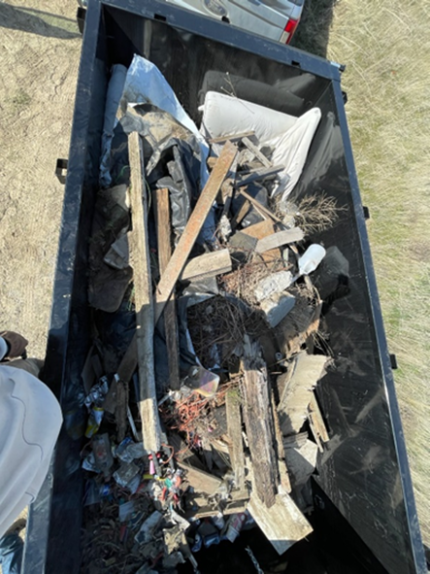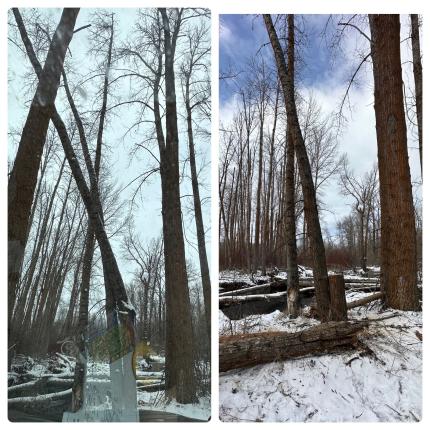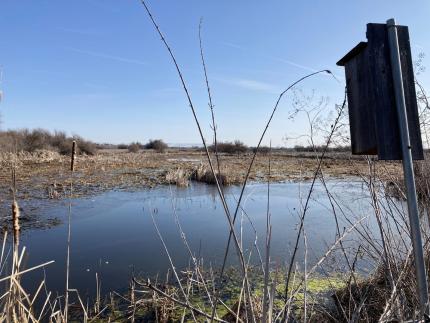Managing Wildlife Populations
California Sight of a Burrowing Owl from Washington: A male burrowing owl banded in June 2022 on the Rattlesnake Unit of the Hanford National Monument as part of a demographic study was found wintering near McKinleyville, California last month. A photographer got several photos of the banded owl to identify its origin. This owl’s coastal northern California wintering grounds is 700 kilometers away and a very different habitat than the shrubsteppe and grassland of its breeding site here in Washington. Resights of banded owls from Washington are infrequent so this sighting provides important data in understanding the wintering grounds and migration of our Washington breeding burrowing owl population.


Artificial Burrows for Owls Ready for Spring: Wildlife Biologist Fidorra and volunteers worked to prepare and repair 65 artificial burrows for burrowing owls on lands surrounding the Tri-Cities.

Cackling and Snow Goose Tagging in Columbia Basin: District 4 Wildlife Biologist Fidorra assisted Waterfowl Specialist Wilson along with additional agency staff and Alaska Fish and Game biologists to capture and tag cackling geese and snow geese for migration studies. California Fish and Wildlife contributed the snow geese tags. Four tags were placed on Taverner’s geese and 17 on snow geese at McNary.

Colockum Elk Surveys: Colockum Wildlife Area Manager Lopushinsky assisted Wildlife Program staff members Moore and Wampole in conducting the annual aerial elk surveys on the Colockum. Staff members used a parking lot at the top of the Wild Horse Wind Farm to launch and refuel the survey helicopter. Colockum Manager Lopushinsky appreciated Assistant District Biologist Wampole choosing a beautiful day to fly and survey elk.

Goose Capture: Biologists Bernatowicz and Wampole assisted Waterfowl Specialist Wilson and biologist from Alaska capture cackling geese as part of an ongoing cooperative study. After a day and a half of watching geese land and walk everywhere but in front of the net, 53 geese were captured. Unfortunately, the majority, 49, were small cacklers and not the wanted Taverner's cackling geese. Four transmitters were deployed on the four Taverner's. It was obvious that the geese were somehow aware of the nets and actively avoiding them. The fields were cattle pastures where lines of hay are common. The rancher even believed the geese were present due to left over alfalfa hay.


Coordination Meeting with the Yakama Nation Wildlife Program: Region 3 Wildlife Program staff attended a meeting with their counterparts at the Yakima Nation. The purpose of the meeting was meant to discuss shared priorities and management objectives including pronghorn, big horn sheep, mountain goat and waterfowl.
Cougar Harvest: District 8 Biologist Bernatowicz sealed a cougar harvested by a tribal member on the Yakama Reservation. The hunter had a lot of questions about cougars and bears, which he believed were numerous on the reservation. The SURVEY123 system did not appear to be set up for tribal harvest as it required Game Management Unit (GMU) and WILD ID.
Elk numbers have been high at the Watt feed site as weather and temperatures fluctuate between sun, snow, rain, and wind and 22 to 42 degrees Fahrenheit. Numbers have been low at the Robinson site with estimates ranging from 1 to 300 and feeding has been based on hay left over from the last feeding, occurring every other day on average. Bulls are just beginning to lose their antlers and feeding is anticipated to end as grass begins to green up with warmer night temperatures.
DATE | SITE | COW/CALF | BRANCHED BULL | SPIKE BULL | Mortality | TOTAL |
|---|---|---|---|---|---|---|
2/11/23 | Watt | 592 | 48 | 16 |
| 656 |
2/11/23
| Robinson | 529 | 47 | 16 |
| 592 |
2/17/23 | Watt | 143 | 19 | 12 | 0 | 174 |
2/27/23 | Watt | 735 | 19 | 31 | 1 | 785 |
2/28/23 | Robinson |
|
|
|
| 350 (estimate) |
3/6/23 | Watt | 693 | 32 | 30 |
| 755 |
3/13/23 | Watt | 625 | 7 | 20 |
| 652 |
Burrowing Owl Data Submitted to WDFW database: District 4 Wildlife Biologist Fidorra compiled and submitted eight years of study data from the Tri-Cities Burrowing Owl Project. This data is important to enter as it feeds the Priority Habitats and Species database which is used in land developers during project siting.
Providing Recreation Opportunities
Wenas Target Shooting Clean Up: Recreation Specialist Frame removed 520 pounds of trash from Sheep Company Road target shooting area and Sheep Company Road and Cottonwood Creek Area. Small campfires composed of trash are common in this area.
Cleaning up Private Lands Hunting Opportunity: Private Lands Biologist Hulett and Private Lands Technician Manderbach cleaned up a private lands access site that has been plagued with litter. In total 9,500 pounds of litter was collected and taken to the transfer station.




Grading Parking Lots: Natural Resource Tech Barbosa has started to grade smaller public access area in the Lower Valley.

Dumping: Natural Resource Tech Barbosa and Access Manager Garcia removed a large dump pile at Duportail public access. Officer Fulton discovered the trash while patrolling the area and informed Manager Garcia of the findings.

Hazardous Tree: Access Manager Garcia removed a hazardous tree that was along the entrance to Teanaway Junction.

Graffiti: Natural Resource Tech Barbosa painted out graffiti at Pond 6, unfortunately the site was tagged again the next day.

There has been a lot of waterfowl activity at the Sunnyside Headquarters Unit. Snow geese, white-fronted geese, and swans have been foraging in the agriculture fields near headquarters.

Providing Conflict Prevention and Education
Rattlesnake Hills Elk: Wildlife Conflict Specialist Hand had contact with landowners on Rattlesnake Mountain concerning current weather conditions and access. Heavy amounts of drifting snow and cold temperatures at the end of February had some roads in the area closed. Elk are continuing to utilize low elevations areas near highway 240 on the Hanford National Monument.
Ringold Beaver Damage: Wildlife Conflict Specialist Hand met with an orchard owner in the Ringold area along the Columbia River that had sustained damage to several of his cherry trees from beavers. Multiple preventative strategies were discussed as well as contact information provided for hiring a licensed nuisance control operator.
New Damage Permit System: Wildlife Conflict Specialist Hand participated on the new damage permit testing team. The first iteration of the permit system had numerous functionality issues and has been scrapped. WDFW Information Technology Division will be working with an outside vendor to start development of a new damage permit development platform with hopes of having a workable solution by early fall 2023.
Kahlotus and Paterson Deer: Wildlife Conflict Specialist Hand continued to conduct deer hazing operations at multiple winter wheat fields in the GMU 381 and wine grape vineyards near Paterson. Current mild weather conditions have deer finding adequate forage in non-crop areas.
Conserving Natural Landscapes
Byron Unit: Assistant Manager Ferguson and Natural Resource Technician Wascisin continued beaver-proofing the culvert underneath an access road in the Byron Unit with additional cattle panels after retaliatory efforts from the resident beavers causing blockages. The panels are keeping the beavers away from the culvert now, but new dams have been created upstream and downstream of the road crossing.

Sunnyside Wood Duck Boxes: Natural Resource Technician Wascisin helped Richland Rod and Gun Club volunteers with yearly cleaning and repair of wood duck nest boxes at the Sunnyside and Byron units.

Sagebrush Planting: Habitat Specialist Miller and Recreation Specialist Frame began planting Sagebrush in the Wenas Wildlife Area. These plantings will help to supplement natural regeneration of sagebrush within the Wenas Wildlife Area. Sagebrush plugs will be planted throughout the Cow Canyon Fire, Cleman Mountain, and sites that burned in the Evans Canyon Fire.
Shrub-Steppe Restoration: Colockum Wildlife Area personnel used the Colockum landing craft to assist in hauling restoration equipment and supplies to an area burned by the 2022 Whiskey-Dick Wildfire. WDFW staff members used the boat to transport an all-terrain vehicle, seeder, harrow and native grass seed to be used for early spring seeding. Access roads to the area are still snowed in making vehicle access difficult.


Colockum Forest Restoration: Work has paused on the Colockum Forest Health Project as we wait for the soft, muddy roads to firm up this spring. WDFW has temporarily closed the last mile of the Ingersoll Road to vehicles, posting signs and blocking the road with logs. Depending on the weather, the road should be back open around April 30.

Providing Education and Outreach
Assistant Manager Winegeart attended the Eastern Washington Riparian Symposium in Ellensburg. The training took place over two days and included a day of presentations and a half day of project site visits. Bottom line, your best chance for successful shrub and tree establishment with plants that like to have their roots in water is to plant deep enough that the roots are still in water during the dry season and beaver dam analogues, when properly engineered, can greatly improve riparian habitat, and help water reach higher elevation terraces that are part of the 100-year flood plain.


Working with Partners on Fire Prevention Strategies: Private Lands Biologist Hulett took part in Bureau of Land Management’s Lower Basin fire prevention meeting. Hulett shared his knowledge and current projects with the group to help combine efforts for fuel breaks on public and private ownership.
Conducting Business Operations and Policy
Sunnyside Maintenance: Assistant Manager Ferguson and Natural Resource Technician Wascisin have been conducting maintenance on the wildlife area heavy equipment, doing fluid changes, filter changes, and any necessary repairs before the spring planting season.

Other
Wenas T-Post Puller Fabrication and Construction: Assistant Manager Taylor, Habitat Specialist Miller, and Recreation Specialist Frame fabricated and assembled seven T-Post pullers for future fence removal projects. The pullers are constructed from square metal tubing and flat bar. Pullers were painted blaze orange for easy visibility. All fabrication and assembly took place in the Wenas shop.
L.T. Murray Hay Damage Issues: Assistant Manager Winegeart fed elk on a few occasions and took note of water damage on some grass and triticale mixed hay. This isn’t the first time the issue of professionally installed hay tarps having holes has surfaced. Hopefully the Joe Watt barn will get a hay shed soon and this will be a problem of the past.
